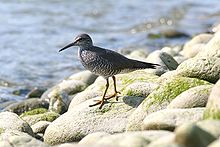Wandering tattler
| Wandering tattler | |
|---|---|

| |
| Scientific classification | |
| Domain: | Eukaryota |
| Kingdom: | Animalia |
| Phylum: | Chordata |
| Class: | Aves |
| Order: | Charadriiformes |
| Family: | Scolopacidae |
| Genus: | Tringa |
| Species: | T. incana
|
| Binomial name | |
| Tringa incana (Gmelin, JF, 1789)
| |

| |
Breeding Migration Nonbreeding
| |
| Synonyms | |
|
Heteractitis incanus | |
The wandering tattler (Tringa incana; formerly Heteroscelus incanus: Pereira & Baker, 2005; Banks et al., 2006), is a medium-sized
Taxonomy
The wandering tattler was

Description
These birds have stocky bodies with gray upperparts, underwings, face and neck and a white belly. They have short dark yellow legs and a dark gray bill. Adults in breeding plumage are heavily barred underneath.
The
Distribution and habitat
In summer, the wandering tattler is found in
.In the nonbreeding season it is well distributed throughout the Pacific, often seeking coastlines and isolated islands.[10]
Behaviour and ecology
Food and feeding
They feed on aquatic invertebrates such as
Breeding
The female lays 4 olive-colored eggs in a shallow depression. Both parents incubate and help feed the young, who are soon able to forage for themselves.
References
- . Retrieved 13 November 2021.
- ^ Gmelin, Johann Friedrich (1789). Systema naturae per regna tria naturae : secundum classes, ordines, genera, species, cum characteribus, differentiis, synonymis, locis (in Latin). Vol. 1, Part 1 (13th ed.). Lipsiae [Leipzig]: Georg. Emanuel. Beer. p. 658.
- ^ Latham, John (1785). A General Synopsis of Birds. Vol. 3, Part 1. London: Printed for Leigh and Sotheby. p. 154-155, No. 29.
- JSTOR 4080770.
- ^ Peters, James Lee, ed. (1934). Check-List of Birds of the World. Vol. 2. Cambridge, Massachusetts: Harvard University Press. p. 270.
- .
- .
- ISBN 978-1-4081-2501-4.
- Rasmussen, Pamela, eds. (August 2022). "Sandpipers, snipes, coursers". IOC World Bird List Version 12.2. International Ornithologists' Union. Retrieved 6 November 2022.
- ^ "Wandering Tattler". Audubon. 2014-11-13. Retrieved 2022-02-26.

